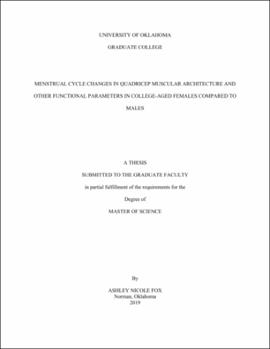| dc.description.abstract | Women have often been excluded from research studies due to the fluctuations of hormones throughout the menstrual cycle and the difficulty in scheduling through different phases and the possible interaction it may have with other testing variables. The purpose of this study was to investigate how the menstrual cycle may affect lower limb muscular architecture and functional parameters, such as: force production, range of motion (ROM) and body composition in females during the follicular (FOL), ovulatory (OV) and luteal (LUT) phases of the menstrual cycle. This study utilized a short-term longitudinal repeated measured design which consisted of 4 visits. There were three groups: Non-contraceptive users (NC), Oral-contraceptive users (OC) and a male control group (CON). Visit 1 began with an explanation of inclusion and exclusion criteria and familiarization for testing equipment. Visits 2-4 were scheduled based off of the participant’s menstrual cycle phase by menstrual cycle questionnaires or estimated in the CON group by: FOL (days 1-4) , OV (days 12-15) and LUT (days 15-18). Visits 2-4 included hip and knee ROM goniometer assessment, a DXA scan, pennation angle (PA) measurements of the vastus medialis (VM), vastus lateralis (VL), rectus femoris (RF), and the anterior portion of the vastus intermedius (VIA) of the dominant leg using B-mode ultrasound and knee extension and flexion maximal voluntary isometric contraction (MVICs) testing on the dominant leg. Sigma Plot (Systat Software, San Jose, CA v. 12.5) was used to perform statistical analysis. Statistical significance was set at p < 0.05. 3-Way Repeated-measures ANOVA was used to identify differences between quadriceps muscle architecture, body composition, ROM and force production during the FOL, OV and LUT phases of the menstrual cycle between groups (OC, NC, CON) and time (FOL, OV, and LUT phases). There were no significant differences found in force production, pennation angle, range of motion or body composition across the three groups (OC, NC, CON) or time points (follicular, ovulatory, luteal), The lack of significant changes in variables between the NC and OC groups indicates oral contraceptives may not play a role in altering changes in body composition, hip and knee ROM, isometric knee strength and quadriceps PA. However, it is important to control for the testing phase for future research studies to minimize error with hormone fluctuation through the menstrual cycle. | en_US |
